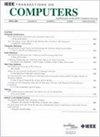teerrollup:使用异构TEE的高效Rollup设计
IF 3.8
2区 计算机科学
Q2 COMPUTER SCIENCE, HARDWARE & ARCHITECTURE
引用次数: 0
摘要
rollup已经成为一种很有前途的方法,通过在链下卸载交易执行来提高区块链的可扩展性。现有的rollup解决方案要么利用复杂的零知识证明,要么乐观地假设执行正确性,除非受到挑战。然而,这些解决方案存在高昂的天然气成本和严重的退出延迟,阻碍了它们在去中心化应用中的应用。本文介绍了TeeRollup,这是一种高效的rollup协议,它利用可信执行环境(tee)来实现低gas成本和短退出延迟。序列者(即系统参与者)在tee内执行事务,并将签名的执行结果上传到区块链,并使用tee的机密密钥。与大多数tee辅助区块链设计不同,TeeRollup采用了一种实用的威胁模型,其中tee的完整性和可用性可能会受到损害。为了解决这些问题,我们首先引入了一个具有异构tee的分布式测序系统,即使一定比例的tee受到损害,也可以确保系统的安全性。其次,我们提出了一种挑战机制来解决TEE不可用带来的可赎回性问题。此外,TeeRollup还集成了数据可用性提供者(Data Availability Providers, DAP)来减少链上存储开销,并使用惰性惩罚机制来规范DAP行为。我们使用以太坊测试网络Sepolia在Golang中实现了TeeRollup的原型。我们的实验结果表明,TeeRollup优于零知识rollup (zk -rollup),将链上验证成本降低了约86%,并将提取延迟降低到几分钟。本文章由计算机程序翻译,如有差异,请以英文原文为准。
TeeRollup: Efficient Rollup Design Using Heterogeneous TEE
Rollups have emerged as a promising approach to improving blockchains’ scalability by offloading transaction execution off-chain. Existing rollup solutions either leverage complex zero-knowledge proofs or optimistically assume execution correctness unless challenged. However, these solutions suffer from high gas costs and significant withdrawal delays, hindering their adoption in decentralized applications. This paper introduces TeeRollup, an efficient rollup protocol that leverages Trusted Execution Environments (TEEs) to achieve both low gas costs and short withdrawal delays. Sequencers (i.e., system participants) execute transactions within TEEs and upload signed execution results to the blockchain with confidential keys of TEEs. Unlike most TEE-assisted blockchain designs, TeeRollup adopts a practical threat model where the integrity and availability of TEEs may be compromised. To address these issues, we first introduce a distributed system of sequencers with heterogeneous TEEs, ensuring system security even if a certain proportion of TEEs are compromised. Second, we propose a challenge mechanism to solve the redeemability issue caused by TEE unavailability. Furthermore, TeeRollup incorporates Data Availability Providers (DAPs) to reduce on-chain storage overhead and uses a laziness penalty mechanism to regulate DAP behavior. We implement a prototype of TeeRollup in Golang, using the Ethereum test network, Sepolia. Our experimental results indicate that TeeRollup outperforms zero-knowledge rollups (ZK-rollups), reducing on-chain verification costs by approximately 86% and withdrawal delays to a few minutes.
求助全文
通过发布文献求助,成功后即可免费获取论文全文。
去求助
来源期刊

IEEE Transactions on Computers
工程技术-工程:电子与电气
CiteScore
6.60
自引率
5.40%
发文量
199
审稿时长
6.0 months
期刊介绍:
The IEEE Transactions on Computers is a monthly publication with a wide distribution to researchers, developers, technical managers, and educators in the computer field. It publishes papers on research in areas of current interest to the readers. These areas include, but are not limited to, the following: a) computer organizations and architectures; b) operating systems, software systems, and communication protocols; c) real-time systems and embedded systems; d) digital devices, computer components, and interconnection networks; e) specification, design, prototyping, and testing methods and tools; f) performance, fault tolerance, reliability, security, and testability; g) case studies and experimental and theoretical evaluations; and h) new and important applications and trends.
 求助内容:
求助内容: 应助结果提醒方式:
应助结果提醒方式:


